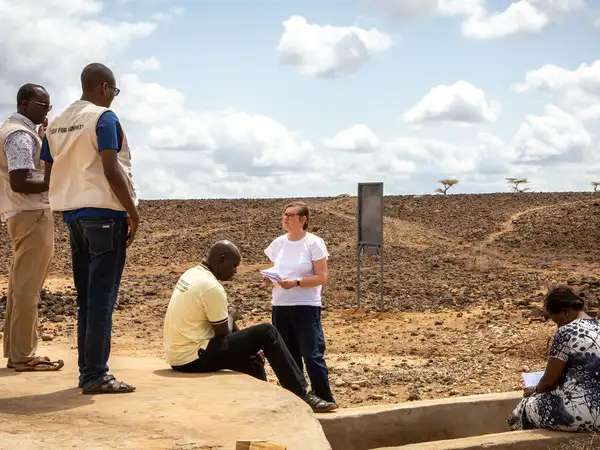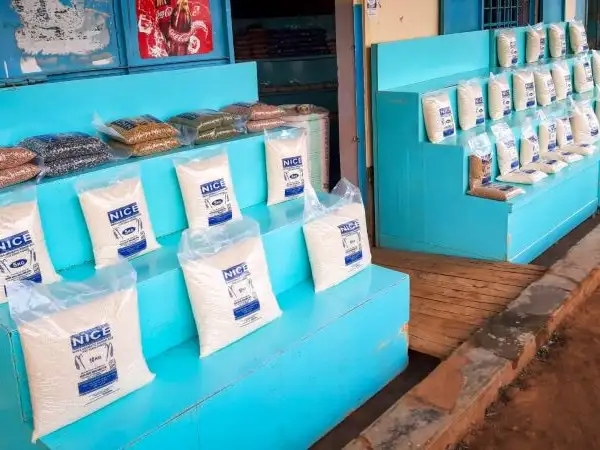Fix the food system
The global food system is broken. It doesn’t work for those who work the hardest – small farmers – and it’s a major driver of the climate emergency.
Millions of people are impacted by the food crisis in East Africa, as CAFOD Director Christine Allen witnessed while visiting communities in Kenya.
On the long road to Marsabit (a nine-hour drive) we saw charcoal sellers and women sat behind small tables piled high with fruit and veg. We passed the huge swathe of cordoned-off land where Del Monte farms its pineapples for export – a stark reminder of how our food system is globally connected.
We stopped to buy rice. The price had risen by 20 Kenyan shillings in the last two months alone.
Catherine Ogolla, CAFOD’s Country Representative for Kenya, told me that the price of cooking oil has doubled as a result of the war in Ukraine. “Everybody is struggling to make a living,” she says.
Two-and-a-half hours out of Nairobi we passed farms with vegetable-filled polytunnels stretching as far as the eye can see. But so much of this nutritious food will not go to the people of Kenya. This is where our food is grown, for our plates.
The large farms are jarringly juxtaposed with the pastoralists scraping a living from the side of a dangerously busy highway.
We passed the equator and continued driving north. It got hotter and drier. Our long drive illustrated the challenges of reaching remote communities in Kenya – communities who are facing one of the worst humanitarian crises in over 40 years.


Christine Allen at a Caritas Marsabit underground water tank.
The situation in Kenya is not just one crisis, it is multiple crises: prolonged drought, devastating swarms of locusts, the Covid-19 pandemic, and rising food and fuel prices.
For pastoralist communities across northern Kenya, who are already some of the most marginalised people in the country, the result is the same: death of livestock. Between October 2021 and March 2022, 1.5 million cattle and sheep died. Now, the people themselves are close to starving to death.
The resilience of pastoralist communities has been stretched beyond breaking point. For pastoralists, livestock are like a savings account – to see them die is the equivalent of having your life savings wiped.
The Archbishop of Nairobi, Most Reverend Philip Anyolo, explained that malnutrition levels have risen, millions of people are now in need of assistance, and how “it is the Gospel mandate to respond”.
The impact of drought is felt most keenly by those who are most vulnerable. Children, lactating mothers and the elderly are most at risk.
Remote pastoralist communities get little help from the government. Their traditional way of life – travelling with their animals across long distances in search of food and water – often puts them outside the reach of standard support structures.
The Catholic bishops of Kenya have launched their own appeal through Kenya’s Church network but are concerned at the lack of interest from the international community. No-one seems to be talking about the food crisis, yet people here are pushed to the brink. In 2017, there was huge international support when Kenya missed two rainy seasons. The communities are now surviving through four.
But Father Ferdinand Lugonzo, General Secretary of the Kenya Conference of Catholic Bishops, is determined to make people listen: “The Church is present. We bring out the facts to be the voice of the voiceless. This is bringing Laudato Si to life. We will do our part. I just appeal for you to donate as much as you can.”
The Church is present. We bring out the facts to be the voice of the voiceless.
Your support can help local experts stop this crisis turning into one of the worst humanitarian tragedies we’ve ever seen.
CAFOD has been working alongside communities across Kenya for over 30 years. Our work, led by local aid experts, has had a huge impact and improved the lives of people living in poverty.


The direct distribution of staple food products is being provided by local experts in remote areas.
Caritas Marsabit, the inspirational organisation we work through, is providing vital humanitarian assistance – cash and vouchers to enable people to buy from local shops and direct food distribution of staples to more remote areas. I saw one such distribution where households were getting 15kg of rice, 7kg of beans and a litre of vegetable oil. This is one month’s supply. In other places this amazing agency is arranging water distribution and repairing underground water tanks.
But in affected areas, we now face a real risk of seeing long-term development work simply reversed.
At CAFOD, we believe that no one is beyond the reach of the love and support they need to flourish. Even though predictions are bleak, there is still hope.
Please give what you can to provide urgent help now to families in East Africa, support communities around the world working hard to put food on the table, and help fight the causes of hunger longer term.
The global food system is broken. It doesn’t work for those who work the hardest – small farmers – and it’s a major driver of the climate emergency.
Pray with us for a fairer global food system where everyone has enough.